Find out how to make beetroot powder for your homemade cosmetics, food colorings, or as a healthy supplement to your diet.
Beetroot powder has been gaining popularity in the last years for a number of reasons.
Many people use it as a supplement to help lower blood pressure, or to boost energy and help detox. Others use it to naturally sweeten while receiving the benefits of its added nutrients. In the natural communities, though, it has become popular due to its beautiful color.
Not only can you use it as a natural food coloring, but you can also grind it into a really fine powder that can be used in homemade natural cosmetics.
A couple of years ago I wanted to do just that. I was looking to make some natural blush with beetroot powder, but couldn’t find any at any local stores. Desperate to try it out, I ordered a bunch of it in bulk online because the shipping costs were higher than the actual product and I figured that if it worked as well as I thought it would, I would eventually use it all up.
Unfortunately things didn’t go as well as I had planned.
First of all the beetroot powder that I bought wasn’t ground very finely, and it didn’t stick to my face when trying to use it as a blush. When trying to use it in lipglosses and the like, it only made a gritty mess!
I gave upon the idea for a while and hid it all away in my cabinet for a couple of months.
Fast forward a few months, I decided that I wanted to try to dye fabric with it. (Don’t expect to get beautifully dyed fuchsia fabric if you try it, but that’s a story for another day.) I went to my cabinet, and was disappointed when I saw that my pretty fuchsia beetroot powder had turned an ugly shade of brown!
I decided that, after having made several types of flour from fruits like carob and coconut, that I could use the same procedure for making my own beetroot powder. No more spending exhorbitant shipping costs or having to buy in bulk. It’s easy to make just the amount you need, when you need it, and have fresh beetroot powder available for your projects and recipes.
It also has several other advantages. You can choose which beets you want to use, whether it be organic or fresh from your own garden, so you know exactly what you are using. You can also dehydrate beetroot chips, which tend to stay bright pink for longer, and wait to grind the up until you need them. I find that when exposed to the air, beetroot powder eventually turns brown, especially if there is any humidity where you have stored it. When well sealed, it will last longer, but if you only grind up as much as you’ll need for several weeks at a time,you can ensure that you’re always using fresh powder.
How to make Beetroot Powder
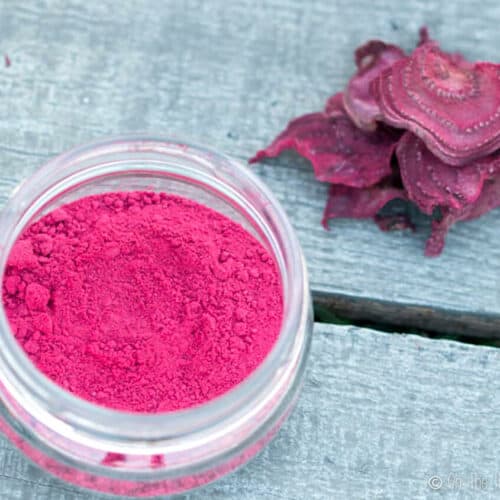
How to Make Beetroot Powder
Ingredients
- 1 beet
Instructions
- Wash and peel fresh beet roots and slice thinly. You can use a food processor to thinly and evenly slice the beetroot quickly.
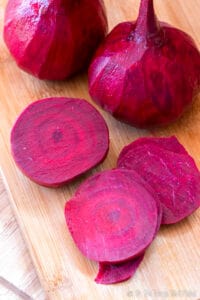
- Dry the slices in a food dehydrator, a convection oven on low heat, or in the sun covered with a net to keep insects from touching them.
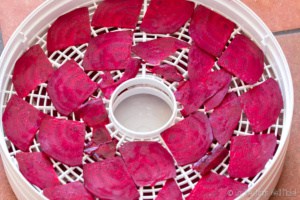
- You can now eat or store your homemade beetroot chips. 🙂
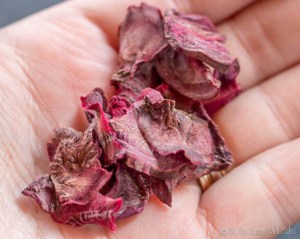
- When you want to make fresh beetroot powder, take a few dried beetroot chips and grind them up finely in a powerful food processor, or in a coffe grinder like I do.
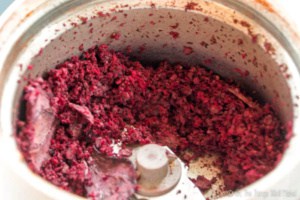
- If you are having a hard time getting the powder fine enough for your use, like when you want to use your beetroot powder as a powdered blush, I’ve found that the best way is to grind with a coffee grinder until the powder starts to accumulate on the cover of the grinder. The powder that builds up on the cover should be very fine and perfect for cosmetic uses. You can easily remove it with a paintbrush.
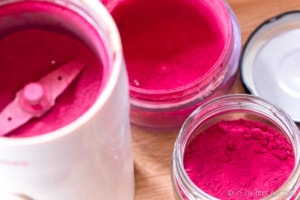
- Store the beetroot powder in an airtight container if possible to keep it fresher for longer.
 Español
Español
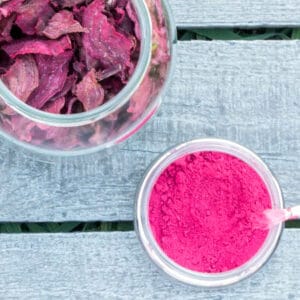
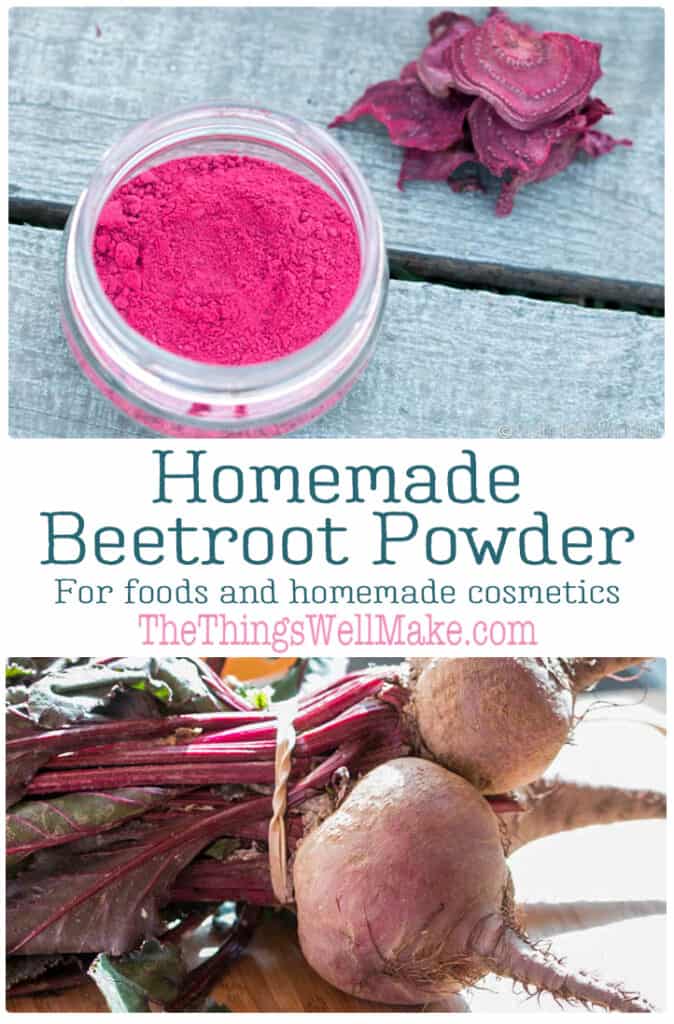
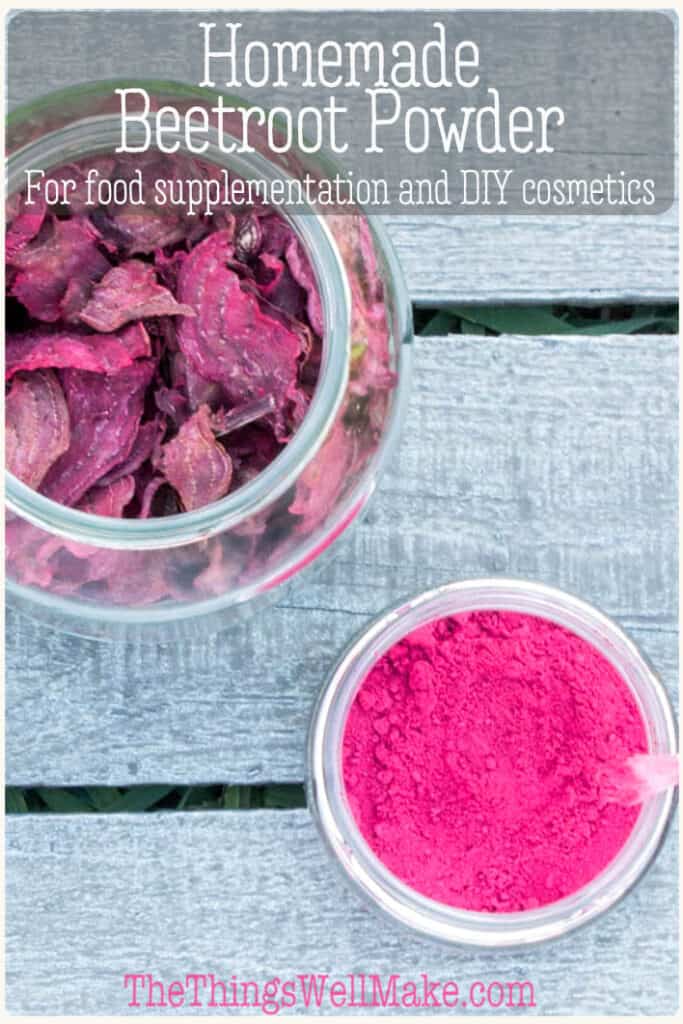
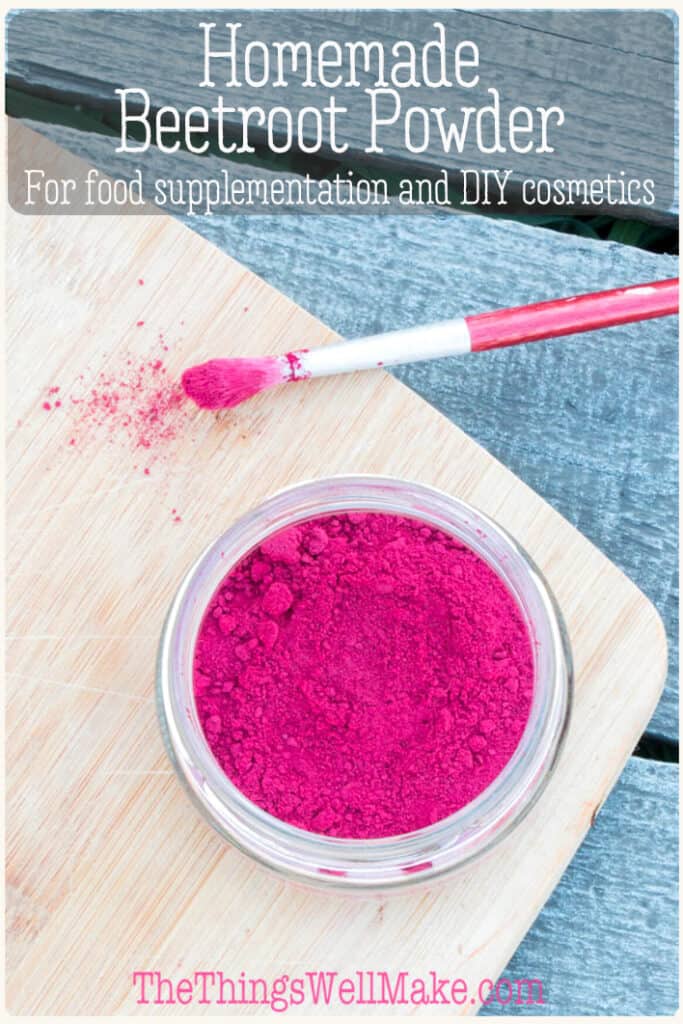
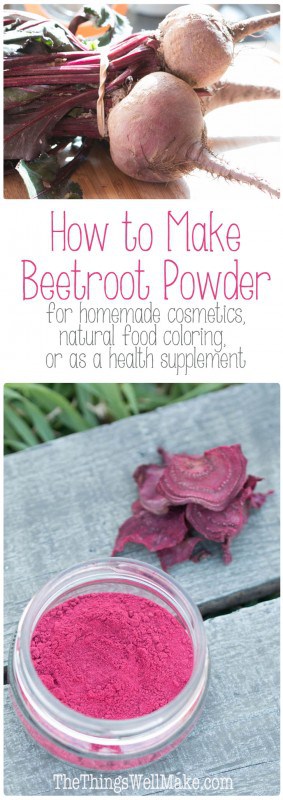
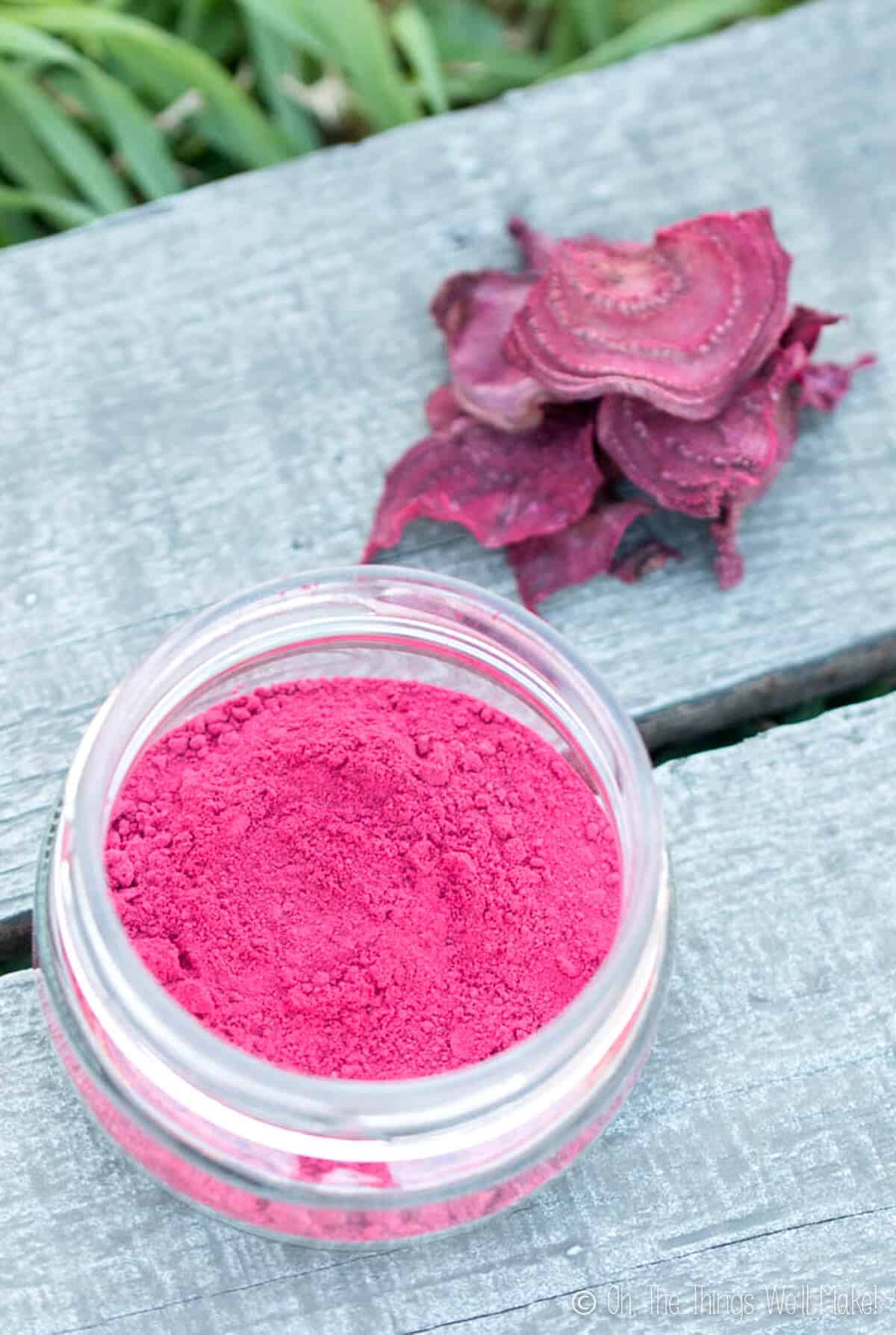
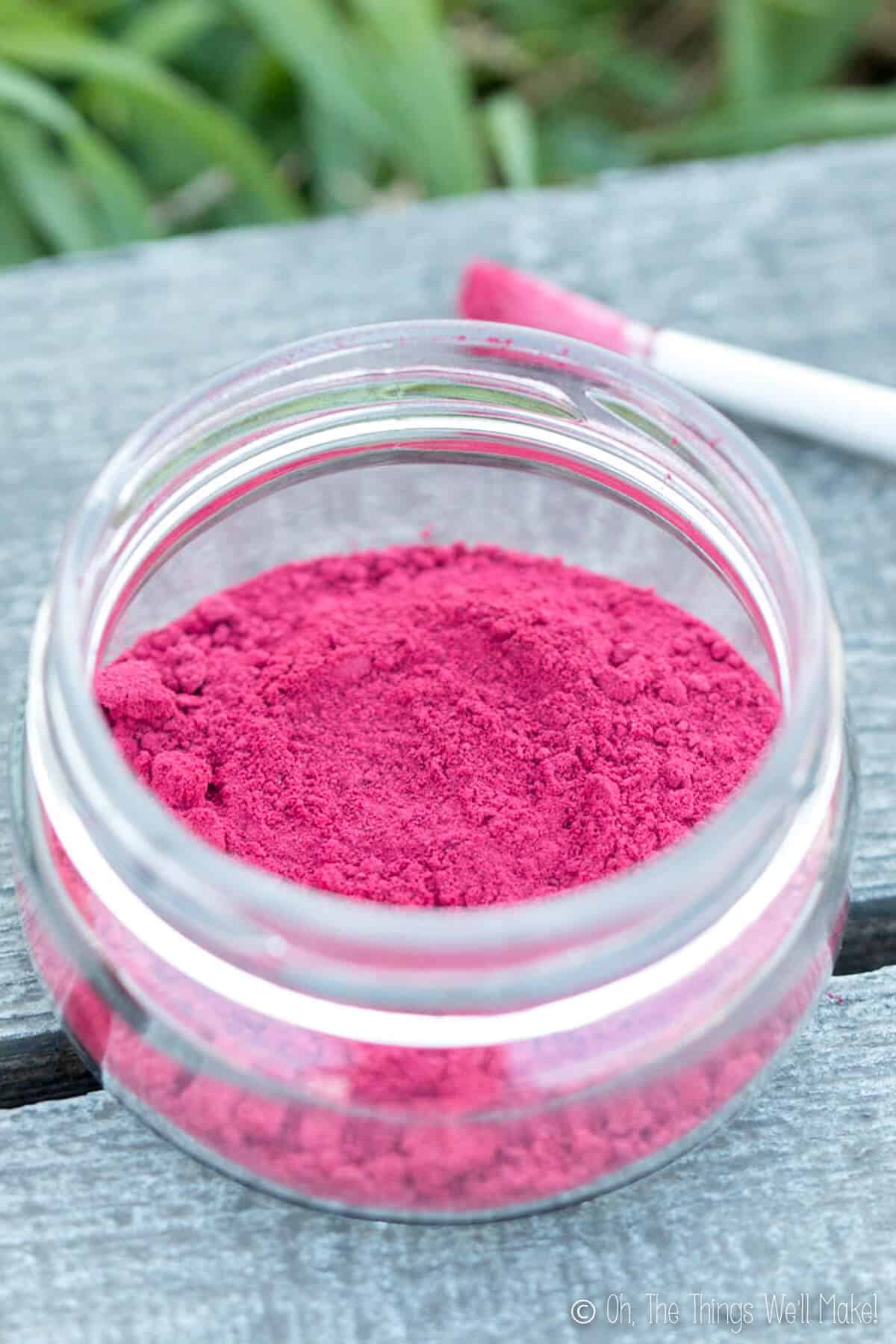
 Paleo linguini with Clam Sauce
Paleo linguini with Clam Sauce
Lucile
Hi. Thanks for the advice on making beetroot powder. I noticed after your first step looking at your photos, making the chips, the chips looked brown. How does the powder come out to such a nice bright red? Thanks
Tracy Ariza
Hi Lucile,
Yes, you’re right about that. I didn’t expect the powder to turn out as bright vibrant pink as it did, but all of those pictures were from the same batch. I’ve been wanting to make a video to show my process. I’ll have to admit that I’m a bit embarrassed to show off my coffee grinder, which is what has been holding me back. 🙂 I need to go out and buy a new one!
I will say one thing. In that batch from the pictures, I thought that by having more surface area after thinly slicing the beetroot in a food processor, that the powder wouldn’t be as vibrant. Despite the fact that it turned out vibrant anyway, I decided to hand slice the next batch, leaving thicker pieces. That batch wasn’t as vibrant as this one. I still have some left of both of them, and neither has turned brown as of yet- something that has really surprised and amazed me.
That’s part of the reason I haven’t experimented again yet. I want to try thinly and more thickly slicing beetroot from the same batch of beets to see if it depends more on the beets you use, or if the thickness of your slices and the way you dry them is more important! As soon as I know for sure, I’ll be updating this post with the new information.
If anyone tries it out before me, I’d love to hear the results!
Wendy Sorel
Does this work for bath salts too? Will my bath salts go brown after a few weeks?
Tracy Ariza
Hi Wendy,
I haven’t tried it with salts, but with sugar, it didn’t go brown for me as long as I had the sugar left. I ended up throwing it out because the high humidity here got to it. You can see in my post about making paleo sprinkles, that even a year later, the shredded coconut dyed with a mixture of beetroot powder and a bit of vodka stayed pretty bright and vibrant.
If you do give it a try, I’d love to heat how it goes.
I’m planning on doing more experimentation with it this summer. 🙂
Farah
Hi Tracy,
I’m trying to incorporate beet powder into my pie crust but just wondering if the colour would change greatly once the pie is baked. I’m hoping to get a pinkish hue not an ugly brown mess.
Tracy Ariza
Hi Farah,
That’s a great question.
To be honest, I’m not really sure.
When I baked them at a very low temperature to dry out coconut sprinkles that I colored with the beetroot powder dissolved in alcohol, the color stayed super vibrant. (You can see the results in my paleo sprinkles post.)
I’m not really sure what would happen when heating at a higher temperature, though. Cooked beets themselves turn a much darker, more burgundy color, and my guess is that it’s very possible that the same thing would happen in a baked good. I haven’t tried it myself yet, though, so I’m really guessing.
If you do give it a go, I’d love to hear about the results! I’d be happy to update the post with your findings, and it could really help a lot of people.
Denise Freitas
I know this is rather late to join this thread, but I want to add my 2 cents to the party. I did try it with cooked beets and for some reason they were leathery instead of brittle out of the dehydrator. Therefore, the pieces would not grind to the fine powder that I was looking for. I tossed those into the compost bin and I’ll pick up some fresh beets to give it another try. If I am successful, I plan to use it for both cosmetic purposes and for a natural food dye for red velvet cake.
Tracy Ariza
Hi Denise,
Yes, It should work a lot better raw. I find that’s generally the case for any sort of homemade food coloring. For example, some people claim to make a green food coloring by boiling spinach, but I have never found that to work. If you use raw, however, you get a beautiful shade of green.
Did you see my post about making homemade natural food coloring?
I actually want to do more experiments with the beets because I get different colors depending upon how thickly the beets were sliced before dehydrating. The super bright pink in these photos came from beets sliced really thinly in my food processor. I did it again, cutting by hand, and the beetroot powder turned more of a mauve color. I’m not sure if it was really the way I sliced it that made a difference, or if it had to do more with the beets themselves.
I want to experiment a few more times before updating the post with the new information. I’m just giving you a heads up in case you decide to experiment yourself. 😉
Denise Freitas
Thank you for your reply. I have a mandolin that I plan to use for slicing to get uniform, thin slices. I’ll look for your post on natural food coloring. I had a cake business for 22 years and Red Velvet was on of my top sellers. I always cringed at the amount of artificial coloring called for in the recipe. I look forward to trying it with the beet coloring.
Chandu
Hi Tracy,
I haven’t tried so far, adding the Beet root powder to the Plain tea powder (i.e with no color – directly from tea factory) as a coloring agent. May I know from your experience, is it worth to have a good color on it.
regards
Chandu
Tracy Ariza
Hi Chandu,
No, I’ve never tried adding beet root powder to a powdered tea, so I have no idea if it would work. Most teas make a dark color, so my guess is that it wouldn’t change things too much, but I’m not sure. Sorry I can’t be of more help.
Mary
Hi 🙂
I recently used a shop-bought bath bomb and enjoyed it so much, I want to try and make my own. I only want to use natural ingredients and thought that beetroot powder would give a nice colour to my bomb. If you had to guess, how much beetroot powder would you think is necessary in order for the bath water to be coloured? I’m not looking for an opaque,vibrant effect but more of a tint. Also, do you believe it would stain the skin or the tub?? Thank you for sharing this technique. I’m going to read through all your other posts now 😉
Tracy Ariza
Hi Mary,
I’m not really sure. I have a feeling that the beetroot powder would give more of a speckled look rather than an all over pink color. If I were you, I’d try infusing the beets into the liquid component of your bath bombs instead. I don’t think it would stain if you were to do it that way. Using the powder might leave a residue and even the powder in the bath, so I personally wouldn’t use it.
You could try either blending beets into a concentrated color and then strain out the pulp, or you could add the powder to a liquid.
I used the powder with vodka to make a long lasting natural food coloring (Check out the link). I’d think you could do the same with whatever alcohol or other liquid you need to use in your bath bombs.
I hope that helps, and I’d love to hear how it goes! I made bath bombs a long time ago, but stopped because we pretty much only shower now. Perhaps I need to go back to an occasional relaxing bath and try it again. 🙂
Melanie
Hi! I make an lip chap with beeswax, castor oil, and peppermint. It’s perfect but it’s missing that tint of color. I want to use a natural stain so after the gloss wears off, your lips will still be tinted from the stain. I want to use beets but I’m not sure if beet powder will go on more like a solid color or might be chalky? Also nervous about the beets turning color in the lip chap. I could use beet juice which I believe would give the proper tinting effect but the liquid I’m afraid will sooner go rancid and change color. I don’t wish to add citrus of any kind to keep the beet stain from turning as my lip chap HAS to be of peppermint. What should I do? I’m so close to making the perfect lip chap but I want a tint that is not chalky, won’t apply as a solid color, and won’t go rancid…. Any ideas please? Are there other alternatives or products that are not powders, are natural, and will stain??? Could I use a natural food colouring? A natural oil base stain would be ideal as it would mix well with my other ingredients. Astaxamthin is too orange and smells like fish… What else might there be??? Hmmm
Tracy Ariza
Hi Melanie,
I’ve been meaning to do a post about that for years now. I’ve been promising to put up my recipe for tinted lipgloss, and just keep putting it off or forgetting.
I’ve done numerous trials with all sorts of colorants. I’ve used beetroot powder, strawberry and raspberry powder, etc., etc. Most get clumpy and don’t work in lip glosses, etc.
Don’t waste your time on any of them! I need to see if I can find my old pictures of the results and crank that post out. Ha! I’ll put it on my calendar for the next few weeks as I’ve also promised to do several other posts that I’ve been promising for awhile first. Sigh.
Meanwhile, though, I’d like to suggest you take a look at my post about my DIY blush stick.
Both of the natural colorants I used there disperse well in oils and give a great overall pigment to homemade cosmetics.
Roxanna Roadarmel
Hi Tracy, Curious as I make sugar scrubs… If I used beetroot powder or any other fruit powder, what shelf life would I get from adding them to my scrubs?
Thanks Roxy
Roxanna Roadarmel
I might not have asked the question just right. By adding a beetroot powder, will that decrease the shelf life of my sugar scrub?
Tracy Ariza
Sorry- I was busy last week/weekend with my son’s birthday party. I’m just now catching up on the blog. 😉
I hope my answer helps!
Tracy Ariza
Hi Roxy,
I’ve never tried adding something like beetroot powder to a scrub, but I wouldn’t think that it would lower the shelf life too much if your scrubs don’t have an aqueous part to them. So, if you were to make a scrub that uses sugar or salt and only oils, for example, adding beetroot powder shouldn’t affect the shelf life by much, as long as the powder was well dehydrated to begin with.
The problems arise when you start adding anything with water to the scrub, or if water starts to get into the container. The humidity is what would cause the problems.
On the other hand, I’m not sure how well the beetroot powder would “dissolve” into a scrub, meaning, I feel like it wouldn’t combine well and would leave bits of beetroot and not a uniform coloring if that’s what you are looking for. I’ve done experiments with natural colorings in lip glosses, and most additives didn’t combine very well. Alkanet and achiote were the best, and that’s why I used them in my homemade blush stick. I need to do a post on it and show my pictures so other people can learn from my experiments. 🙂
Good luck. I’d love to hear how it goes!
Dell
Have you tried without peeling the beets?
Tracy Ariza
Hi Dell,
No, I haven’t. I like to get a nice, bright pink beetroot powder for using in homemade food colors and homemade makeup mostly, and I think the outer part would be more likely to add in brown tones to it. I wouldn’t think it would cause issues for food uses, though. I’d never really given it much though, and have just always peeled them before using them for anything.
Benoit
Just stumbling across this recipe as I have an excess of beets today from our spring greenhouses in need of a happy home. Thank you for this post Tracy and what appears to be a delightfully wonderful and thoughtful site.
To anyone who has had this question, the skin, the protective layer of foods, is where the most protective elements are — think antimicrobials, antioxidants and other phytonutrients. They are mostly the pigments that give your fruits and vegetables their dark outer tint …the darker your food, usually the better.
For nutritional purposes (and assuming your food is chemical free) it is good practice to be suspicious of throwing the peels of things out!
And if you are making this powder for dye or coloring agents, why not go 2 for 1? Save the skins and simply make a second batch using these already thin outer peelings to make your “chips”. You will have your dye AND a super nutrient dense powder for your morning smoothie.
Tracy Ariza
Hi Benoit!
Thank you so much for your comment and your tip!
That makes a lot of sense! 🙂
If you need your powder to be a bright color, you can also add the peels to smoothies. That’s what I usually do with them. 😉
June
One question, can anyone tell me does drying the beets reduce the earthy flavour, I know someone who doesn’t like that taste?